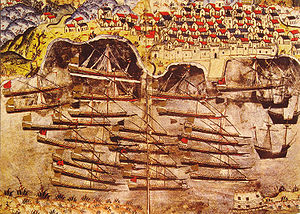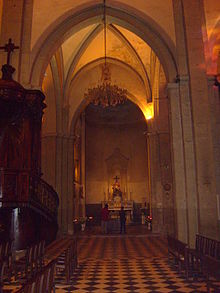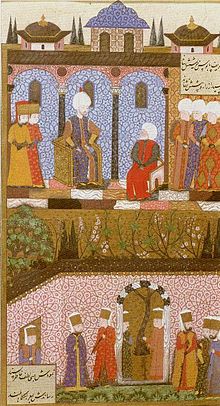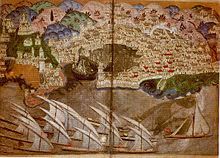- Ottoman wintering in Toulon
-
 Barbarossa's fleet wintering in the French harbour of Toulon, 1543, with the recently built Tour Royale (bottom right).
Barbarossa's fleet wintering in the French harbour of Toulon, 1543, with the recently built Tour Royale (bottom right).
The Ottoman wintering in Toulon occurred during the winter of 1543-44, following the Franco-Ottoman Siege of Nice, as part of the combined operations under the Franco-Ottoman alliance.
Contents
Wintering in Toulon
The Ottomans were offered by Francis I of France to winter at Toulon, so that they could continue to harass the Holy Roman Empire, and especially the coast of Spain and Italy, as well the communications between the two countries:
"Lodge the Lord Barbarossa sent to the king by the Great Turk, with his Turkish Army and grands seigneurs to the number of 30,000 combattants during the winter in his town and port of Toulon... for the accommodation of the said army as well as the well-being of all this coast, it will not be suitable for the inhabitants of Toulon to remain and mingle with the Turkish nation, because of difficulties which might arise"Only the heads of households were allowed to remain in the city, with the rest of the population having to leave, on pain of death. Francis I indemnified the inhabitants by exempted them from the taille tax for a period of 10 years.[2]
During the wintering of Barbarossa, the Toulon Cathedral was transformed into a mosque, the call to prayer occurred five times a day, and Ottoman coinage was the currency of choice. According to an observer: "To see Toulon, one might imagine oneself at Constantinople".[3]
Throughout the winter, the Ottomans were able to use Toulon as a base to attack the Spanish and Italian coasts under Admiral Salih Reis.[4] They raided and bombarded Barcelona in Spain, and Sanremo, Borghetto Santo Spirito, Ceriale in Italy, and defeated Italo-Spanish naval attacks.[5] Christian slaves were being sold in Toulon throughout the period.[6]
Sailing with his whole fleet to Genoa, Barbarossa negotiated with Andrea Doria the release of Turgut Reis.[7]
Barbarossa found the Toulon base very pleasant and convenient, could refit his ships at the expense of France, and could maintain an effective blockade of Christian shipping. The Lord Lieutenant of Provence complained about Barbarossa that "he takes his ease while emptying the coffers of France".[4]
The Ottomans finally departed from their Toulon base after a stay of 8 months, on 23 May 1544, after Francis I had paid 800,000 ecus to Barbarossa.[8][2] All Turkish and Barbary corsairs had to be freed from French galleys also, as a condition to his departure.[2] Barbarossa also pillaged 5 French ships in the harbour of Toulon in order to provision his fleet.[2]
Return to Istanbul
 The French galleys of Captain Polin in front of Pera at Constantinople in August 1544, drawn by Jérôme Maurand.
The French galleys of Captain Polin in front of Pera at Constantinople in August 1544, drawn by Jérôme Maurand.
Five French galleys, under the command of the "Général des galères" Captain Polin, accompanied Barbarossa’s fleet, on a diplomatic mission to Suleiman.[8] The French fleet accompanied Barbarossa during his attacks on the west coast of Italy on the way to Istambul, as he laid waste to the cities of Porto Ercole, Giglio, Talamona, Lipari and took about 6,000 captives, but separated in Sicily from Barbarossa’s fleet to continue alone to the Ottoman capital.[9]
This would be one of the last naval campaigns of Barbarossa, who died 2 years later in Istanbul in 1546.[10]
Aftermath
Toulon would again be used as a safe harbour for several months by Turgut Rais from August 1546, when he was pursued by the fleet of Andrea Doria.[11]
Notes
- ^ Lamb, p.229
- ^ a b c d The rise and fall of Renaissance France, 1483-1610 by Robert Jean Knecht p.181
- ^ Crowley, p.74
- ^ a b Suleiman the Magnificent - Sultan of the East by Harold Lamb p.230
- ^ Firearms of the Islamic world in the Tareq Rajab Museum, Kuwait Robert Elgood p.38
- ^ The cambridge modern history p.77
- ^ Piracy Angus Konstam, p.85
- ^ a b Crowley, p.75
- ^ Crowley, p.75-79
- ^ Penny cyclopaedia of the Society for the diffusion of useful knowledge p.428
- ^ Piracy: the complete history by Angus Konstam p.87
References
- Roger Crowley, Empire of the sea, 2008 Faber & Faber ISBN 9780571232314
Categories:- Naval history of the Ottoman Empire
- Military history of France
Wikimedia Foundation. 2010.





